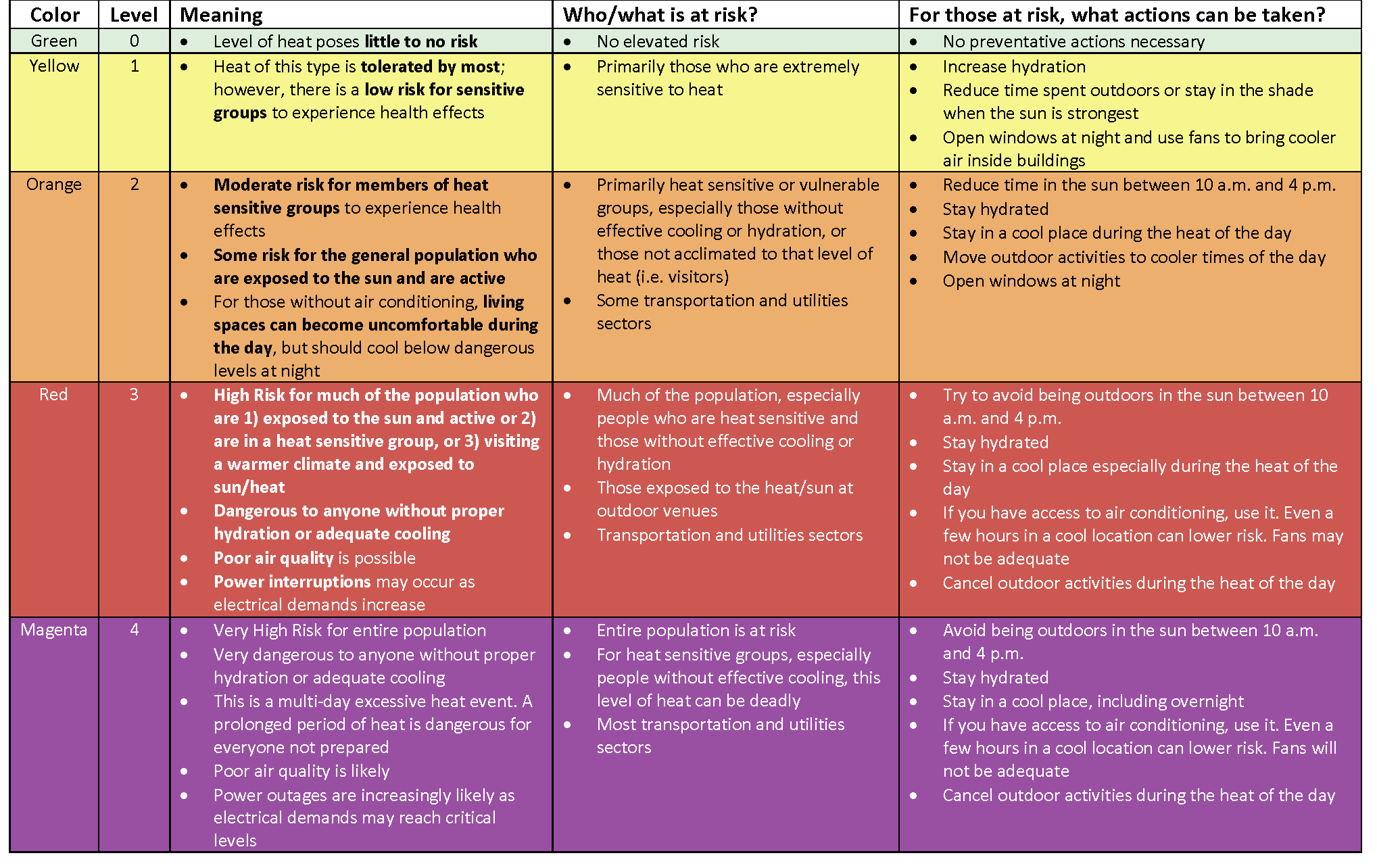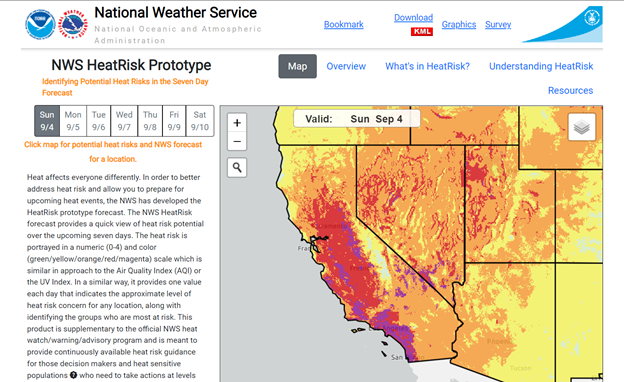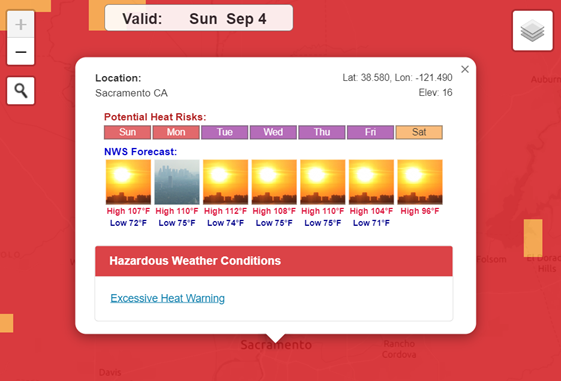CDPH Interim Health Guidance for Schools on Sports and Strenuous Outdoor Activities during Extreme Heat
September 6, 2022
The CDPH interim health guidance provides additional or supplemental information and guidance; if a school or local jurisdiction has an existing heat emergency plan, consult with the existing plan first.
What Is the Risk Of Exercising During Heat Events?
High temperatures can kill. Heat-related deaths and illness are preventable, yet more than 700 people die from extreme heat every year in the United States. Among teenage athletes, heat illness is the third major cause of death. All students and student athletes are susceptible to the risks of exercising in a hot environment, particularly those in high-exertion sports such as football where most heat-related illnesses occur. Rates of exertional heat illness among high school athletes are higher in American football than all other sports combined, averaging four incidents of heat illness per 100,000 exposures.[1]
Key Take-Aways:
- Know your location's "HeatRisk" level. Cancel all outdoor and un-conditioned indoor activities when the HeatRisk level is Red or Magenta during the heat of the day. Find your HeatRisk level here: NWS HeatRisk forecast (for details, see the HeatRisk grid (PDF)[2]). If in doubt, cancel.
- Reschedule events to another day when the HeatRisk level is no longer Red or Magenta, or to another time of day, when the temperature is one to which the students have acclimated, for example, very early morning.
- Move to alternative activities in an air-conditioned or cooled indoor environment if the HeatRisk level is forecasted to be Red or Magenta.
- Multiple days of extreme high temperatures will make students and athletes more vulnerable to exertional heat-related illness, even at lower temperatures.
- Always monitor for exertional heat-related illness because there are multiple contributing factors of which temperature is just one. Humidity, wind speed, and sun angle are other environmental contributors to the risk of heat-related illness.
- Review guidance below. If a circumstance is unclear/uncertain, cancel or reschedule the event, or move the event to alternative activities in a cooled indoor environment.
Life threatening heat-related illness, also known as exertional heatstroke, can occur within the first 60 minutes of exertion and may be triggered without exposure to high ambient temperatures.
[3] Numerous factors can contribute to this including lack of acclimatization, lack of physical fitness, being overweight, taking medications, and other factors. Coastal areas not accustomed to higher temperatures will have more persons that are not acclimated. Acclimatization requires 1 to 2 weeks.
Because the current heat wave is extensive and has new extreme high temperatures, in general, very few, if any outdoor activity participants, are acclimated. Therefore, proceeding with extra caution is necessary. Consult with the school's or local health department's heat emergency plan first. This guidance does not replace your local plans. As additional guidance, review the information below.
How Do I Find My "HeatRisk" Level? (Is It Too Hot for Outdoor Physical Activities?)
National Weather Service HeatRisk Prototype. Map and grid (and definition of "heat sensitive groups" in Overview Tab) available on the NWS website.

What Other Proactive Steps Can Be Taken?
Administrators, coaches, or other organizers should take measures to make sure participants stay cool, stay hydrated, stay connected, and stay informed. Make sure water is available during outdoor activities, including water activities. Encourage water consumption. Evaluate current conditions regularly and make appropriate adjustments – for example, postpone or reschedule practices whenever possible to be held early in the morning or late in the evening to avoid times when heat is generally more severe.
Closely monitor participants and ask these questions:
- Are they drinking enough water?
- Do they have access to air conditioning?
- Do they need help keeping cool?
- Are they exhibiting signs and symptoms of heat-related illness (see further information below)?
Remind participants:
- Getting too hot can make them sick.
- Limit their outdoor activity, especially midday when the sun is hottest.
- Pace their activity. Start activities slowly and pick up the pace gradually.
- Drink more water than usual and don't wait until they're thirsty to drink more. Muscle cramping may be an early sign of heat-related illness.
- Wear loose, lightweight, light-colored clothing.
Everyone should take these steps to prevent heat-related illnesses, injuries, and death during hot weather:
- Stay in an air-conditioned indoor location as much as you can.
- Drink plenty of fluids even if you don't feel thirsty.
- Schedule outdoor activities carefully.
- Wear loose, lightweight, light-colored clothing and sunscreen.
- Pace yourself.
- Take cool showers or baths to cool down.
- Check on other participants or teammates and have someone do the same for you.
- Check the local news for health and safety updates.
Signs and Symptoms of Heat Related Illness (HRI)
- Muscle cramping
- Dizziness
- Headache
- Weakness
- Hot and wet or dry skin
- Flushed face
- Rapid heartbeat, low blood pressure
- Hyperventilation
- Vomiting, diarrhea
- *Behavioral/cognitive changes (confusion, irritability, aggressiveness, hysteria, emotional instability, impaired judgement, inappropriate behavior)
- *Drowsiness, loss of consciousness
- *Staggering, disorientation
- *Difficult speaking, slurred speech
- *Seizures
The California Interscholastic Federation provides a free "Heat Illness Prevention" training as well as web pages outlining the identification and treatment of heat exhaustion, heat stroke, heat syncope, exertional hyponatremia, and heat cramps. See: Heat Illness - California Interscholastic Federation
For more information on signs, symptoms, and how to treat heat-related illness, visit the CDC website.
Treatment Of Exertional Heat Stroke[4]
Treatment must be provided immediately and includes:
- Removal of all equipment and excess clothing, cooling the athlete as quickly as possible within 30 minutes via whole body ice water immersion (place them in a tub with ice and water approximately 35–58°F).
- Stir water and add ice throughout cooling process.
- Maintain airway, breathing and circulation.
- After cooling has been initiated, activate emergency medical system by calling 911.
- Monitor vital signs such as core temperature, heart rate, respiratory rate, blood pressure, and Central Nervous System status.
- Cease cooling when core temperature reaches 101–102°F (38.3–38.9°C).
| Exertional heat stroke has a high survival rate when immediate cooling via cold water immersion or aggressive whole-body dousing in cold water is initiated. Immediate means within 10 minutes of collapse. |
What Factors Increase the Risk of Heat Related Illness (HRI)?
- Students' personal factors. Age, obesity, fever, dehydration, heart disease[5], mental illness, poor circulation, sunburn, and prescription drug and alcohol use all can play a role in whether a person can cool off enough in very hot weather.
- Exertion level. Even young and healthy people can get sick from the heat if they participate in strenuous[6] physical activities such as Physical Education during hot weather without gradually acclimatizing to hot conditions over a period of 1–2 weeks.
- High humidity. When the humidity is high, sweat won't evaporate as quickly. Evaporation of sweat is the main way the body can cool itself.
How Do I Use the NWS "Heatrisk" Forecast?
In order to better address heat risk and allow you to prepare for upcoming heat events, the National Weather Service (NWS) has developed the HeatRisk prototype forecast. The NWS HeatRisk forecast provides a quick view of heat risk potential over the upcoming seven days. The heat risk is portrayed in a numeric (0-4) and color (green/yellow/orange/red/magenta) scale which is similar in approach to the Air Quality Index (AQI) or the UV Index.
In a similar way, it provides one value each day that indicates the approximate level of heat risk concern for any location, along with identifying the groups who are most at risk. This product is supplementary to the official NWS heat watch/warning/advisory program and is meant to provide continuously available heat risk guidance for those decision makers and heat sensitive populations* who need to take actions at levels that may be below current NWS heat product levels.

How to Use the NWS HeatRisk Prototype:
- Go to the NWS HeatRisk Prototype web page
- Click map for potential heat risks and NWS forecast for a location, OR
- Click the magnifier icon and type in your address or location
- Once address / location entered, the tool will display the NWS forecast for the current day and the next six (6) days (for a total of seven [7] days of forecasted conditions), including high and low temperatures, and potential heat risk (with HeatRisk levels indicated by the colors green/yellow/orange/red/magenta). Additionally, information about hazardous weather conditions will be provided. See example screenshot for Sacramento, California below:
 NW HeatRisk Prototype forecast, Sacramento, California. Accessed September 4, 2022.*
NW HeatRisk Prototype forecast, Sacramento, California. Accessed September 4, 2022.*The NWS defines "
heat sensitive groups" as:
- the elderly and the very young;
- those on certain medications and/or those with preexisting conditions which make them more sensitive to heat;
- those working outdoors – especially new workers, temporary workers, or those returning to work after a week or more off;
- those exercising or doing strenuous activities outdoor during the heat of the day – especially those not used to the level of heat expected, those who are not drinking enough fluids, or those new to that type of activity;
- those without a reliable source of cooling and/or hydration;
- those not acclimated to the level of heat expected – especially those who are new to a much warmer climate.
Pregnant people are also more vulnerable to heat-related illness; and extreme heat is associated with increased risk of preterm birth and stillbirth.
References & Resources
Cal/OHSA / California Department of Industrial Relations (DIR):
Additional Information
Heat risk and young athletes — rising temperatures lead to lawsuits and environmental injustice (theconversation.com)
[1] Boden BP, Breit I, Beachler JA, Williams A, Mueller FO. Fatalities in high school and college football players. Am J Sports Med. 2013 May;41(5):1108-16. doi: 10.1177/0363546513478572. Epub 2013 Mar 11. PMID: 23477766.
[2] Based on the National Weather Service's [NWS] HeatRisk prototype forecast, which provides a color and numeric value that places forecast heat for a specific location into an appropriate level of heat concern, along with identifying groups potentially most at risk at that level. See here: https://www.wrh.noaa.gov/wrh/heatrisk/
[3] Epstein, Y., & Yanovich, R. 2019. Heatstroke. New England Journal of Medicine, 380(25), 2449-2459. https://www.nejm.org/doi/full/10.1056/NEJMra1810762
[5] Note that common illnesses can also be exacerbated by extreme heat including autoimmune conditions; asthma, COPD, and allergies; migraines; heart disease; and autoimmune diseases including multiple sclerosis (MS), lupus, and rheumatoid arthritis (RA).
[6] Vigorous activity is defined by the Centers for Disease Control as activities greater than 6.0 METs. Specific examples can be found at www.cdc.gov/nccdphp/dnpa/physical/pdf/PA_Intensity_table_2_1.pdf